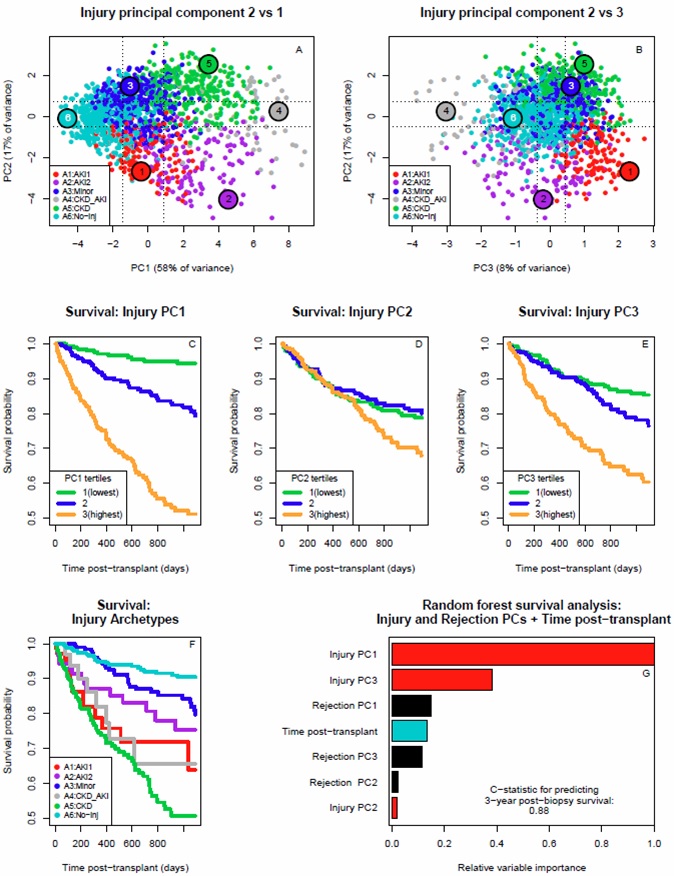Understanding the Molecular Phenotype of Kidney Injury
1University of Alberta, Edmonton, AB, Canada, 2., ., AB, Canada
Meeting: 2020 American Transplant Congress
Abstract number: 91
Keywords: Kidney, Renal injury, Survival
Session Information
Session Name: Biomarkers, Immune Assessment and Clinical Outcomes I
Session Type: Oral Abstract Session
Date: Saturday, May 30, 2020
Session Time: 3:15pm-4:45pm
 Presentation Time: 3:39pm-3:51pm
Presentation Time: 3:39pm-3:51pm
Location: Virtual
*Purpose: The injury status of transplanted organs is a strong predictor of graft loss. We used injury-related gene expression to explore the relationship between function, graft loss, and the molecular phenotype.
*Methods: Using microarrays, we performed unsupervised principal component and archetypal analysis (PCA, AA) on injury-related gene expression in 1526 kidney transplant indication biopsies (31% with rejection), collected in the prospective observational INTERCOMEX study. Eight previously developed gene sets and four molecular classifiers reflecting acute kidney injury (AKI) and chronic kidney disease (CKD) were used as inputs.
*Results: Archetypal analysis resulted in six molecular clusters. Fig 1A and B show the distribution of 1526 biopsies on PC plots colored by archetype groups. We categorized the groups as: A1) AKI1; A2) AKI2; A3) Minor abnormalities; A4) CKD/AKI; A5) CKD; and 6) No injury. Graft loss was strongly associated with PC1 and PC3 , but not PC2 (Fig 1C-E). PC1 reflects overall injury (both AKI and CKD) and was associated with increased expression of AKI-related genes (e.g. ANXA2, ANXA1, and VCAN) and loss of genes related to function. PC2 was associated with time post-transplant, immunoglobulin and mast cell genes, and separated CKD (high PC2) from AKI (low PC2). PC3 was positively correlated with epithelial polarity and adherens junction genes such as PARD3 and ITGB5. PC1 and PC3 were associated with decreased function. The six archetypes varied with respect to their survival probabilities (Fig. 1F). CKD, CKD_AKI, and AKI1 had the highest risk of failure. Half of the 80 samples from patients with delayed graft function were in the AKI1 group. When combined with rejection phenotypes from previous analyses of the same samples, injury was seen to be a better predictor of 3-year post-biopsy graft loss than rejection (Fig 1G). PC3 and more specifically the AKI1 archetype are negatively associated with both TCMR and damage associated molecular patterns genes (DAMPs). Rejecting kidneys with low PC1/PC3 scores have relatively good 3 year survival probabilities.
*Conclusions: Unsupervised analysis of parenchymal injury in kidney transplant biopsies found two distinct injury patterns that result in increased graft loss. The first was overall injury (PC1), exemplified by late CKD. More surprisingly, an early group, typically found to be non-rejecting, and corresponding roughly to delayed graft function samples, was also found. Low expression of DAMPs in this group suggest that an inadequate response to injury may be the cause of their increased incidence of graft loss.
To cite this abstract in AMA style:
Reeve J, Halloran P. Understanding the Molecular Phenotype of Kidney Injury [abstract]. Am J Transplant. 2020; 20 (suppl 3). https://atcmeetingabstracts.com/abstract/understanding-the-molecular-phenotype-of-kidney-injury/. Accessed December 15, 2025.« Back to 2020 American Transplant Congress

